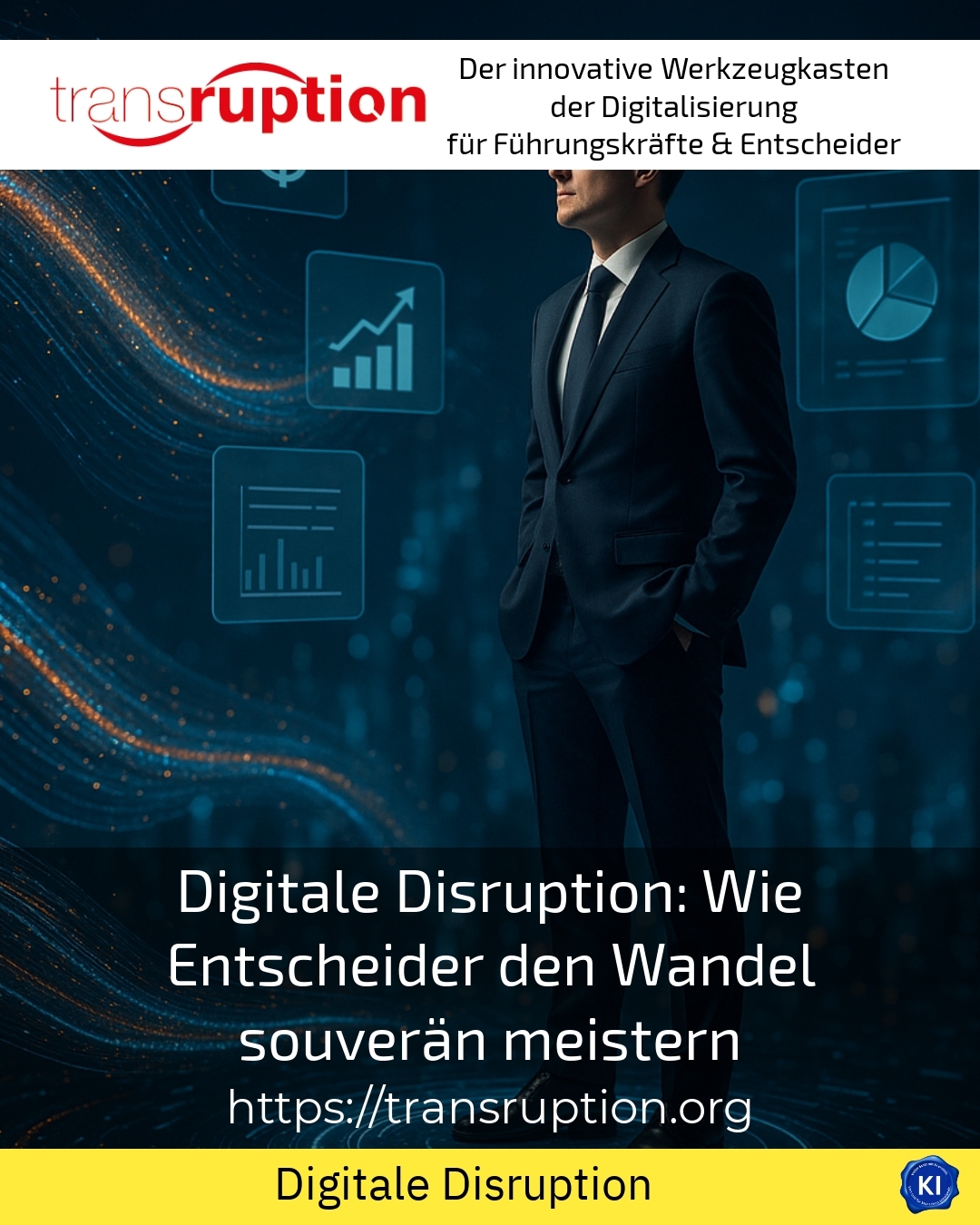Introduction
If you want to digitally transform your company or insurance company, you can reduce the risk of being overtaken by many competitors in the market. You should therefore consider utilising the change process in the insurance industry as a major opportunity in the near future. One of the most important terms here is "self-disruption". Many insurance companies and organisations have not yet understood what exactly disruption actually means.
Executive Vice President Christoph Keese of Axel Springer Verlag provoked with this slogan many months ago at the Tech Open Air in Berlin. Many manufacturers in the automotive industry had already opened up their systems to Apple and Google at that time. As a result, some internet giants were able to easily position themselves between car manufacturers and customers. But what exactly does disruption mean now? Translated from English, the term means to disrupt or tear apart. This term often leads to misunderstandings about the meaning of disruption.
The principle of disruption comes from Clayton M. Christensen of Harvard Business School.
What are the benefits of Watson and Alexa?
The Watson system first hit the headlines back in 2011 on the popular US game show Jeopardy. In this show, Watson beat two masterminds. Since then, the system has been further revolutionised and used for the market of digital products. The technology has also opened up completely new possibilities for the automotive insurance industry. The system can analyse and simultaneously assign several billion pieces of data within a few seconds. The computer is also able to learn more and more. For the insurance industry, this means that a lot of work and time can be saved. The possible applications of the system are unlimited.
In addition to the insurance industry, it can also be very helpful in research, in supporting experts, in development and teaching and in optimising products, services and processes. In the meantime, Watson is no longer alone. A smaller version has come onto the market, which can be seen as the system's little sister. However, Alexa is still primarily used in the private sphere. The use of Alexa should not only be fun, but also useful.
Many experts assume that a
Customer expectations are constantly rising. In addition, disruptive technologies and increasing regulation are putting car insurance companies in a tight spot. If an insurance company wants to be successful in the market, it must invest in the use of new technologies such as Watson and Alexa. All sales and communication channels must be digitally transformed. Back then, banks started to give digitalisation free rein with FinTech. Today, this system is continuing with InsurTech for the general insurance sector. But what are the benefits for insurers and their customers?
A special feature of the transformation of insurance companies is the optimisation, digitalisation or centralisation of recurring and redundant processes. Chatbots equipped with artificial intelligence are already in use in many industries. They are able to hold regular informational conversations with customers using text input in the chat. As a result, hundreds of thousands of insurance conversations per year can be taken over by the system through the transformation of insurance companies.
In the past, these conversations were conducted in call centres or by insurance advisors. Nowadays, digitalisation in the insurance industry means that Siri, Alexa and Cortana are the main tools used. With the help of this artificial intelligence, it is already possible to capture most complex issues in the form of a diaglogue procedure. You should therefore also operate your insurance company with a chatbot as soon as possible. Many customer questions can be dealt with directly day and night.
New customer incentives through digitalisation of the insurance industry
Many insurance customers also use many apps and channels in their private lives to make their everyday lives easier. They also use them to regularly find out about the latest offers on the market. In terms of transparency and security, customer expectations are constantly increasing as a result.
A lengthy process that often results from a consultation or opaque bureaucratic processes do not necessarily meet the expectations of customers. If you want to retain your customers for your car insurance, then you need attractive incentives.
Prevention or no claims should always be particularly rewarded. Develop your own insurance models in which you motivate your policyholders through incentives. You should also motivate their behaviour for the benefit of the customer or policyholder.
This can take the form of a vehicle cleaning service or a voucher for a tyre change, for example. You may even come up with your very own ideas that will put your insurance company ahead of your competitors on the market. You can only win if you motivate your policyholders to co-operate, thereby building trust and strengthening the sense of belonging.
Digitalisation of the insurance industry with a large customer base
At your insurance company, you often have to deal with a lot of customer data on a daily basis. By digitising the insurance industry, you will be able to use a 360° view of your policyholders in the future. You should use social profiling for this. This allows you to quickly and easily utilise interesting data from the various social networks of your insurers.
This gives you an insight into the actions, characteristics and brand loyalty of your insurers. However, you do not gain this insight for your existing policyholders, but also for prospective customers. The information relates in particular to who your customers are and which brands they use most frequently. You can also find out what qualifications an insurer has and in which sector they work.
Which digital profiles are used and with which providers is the insured person already registered?
This gives you the opportunity to get an accurate picture of each insurer. Is it a father, landlord, patient, car enthusiast, motorist or house builder?
Social profiling allows you to utilise and plan any upselling or cross-potential much better. At the same time, you have the opportunity to retain your insurers more easily with optimised offers.
Digital workplaces are not location-bound
Another advantage of the digitalisation of the insurance industry is that workplaces do not require a specific location. Mobile devices enable flexible access to business applications offline at any time, mobile and completely independent of time, location, device or operating system.
The Digital Workspace also enables your insurance company and your employees to utilise a working environment that is very similar to the usage habits of digital natives. This has the advantage for you that communication and collaboration become much more agile, productive and flexible.
In the insurance industry, digital workspaces are still very common in InsurTech start-ups. The system makes administrative, communication and sales processes much more efficient and flexible if you utilise Work 4.0. You gain a great advantage when you use the new applications, as they are very easy to use and you can always access relevant information depending on the situation. This is made possible by many different technologies such as business intelligence, data quality tools and predictive analytics.
Improving the industry's reputation
Many insurance companies are still considered very conservative today, as the business model has remained the same for many years. The digitalisation of the insurance industry and the European Central Bank's low interest rate policy are changing the industry abruptly.
The term disruption in the insurance industry is currently on everyone's lips. Through ground-breaking innovations and radically changed conditions, the system is calling into question many things that were previously taken for granted in car insurance. These developments also affect insurers. After all, the digitalisation of the insurance industry has not yet really been implemented. The situation has been very different in other sectors in recent years. Many companies have taken advantage of digitalisation to advance in the market and retain customers.
If you look at companies such as Amazon, for example, you quickly realise that data analytics systems save them a lot of work and simplify some processes. Data analyses and digital processes are modern and appeal to young customers and policyholders in particular. The younger target group does not want to have an insurance advisor next to them on the couch. They also don't want to be fed unnecessary information. Instead, they want a way to receive concise answers to specific questions that they can understand.
Changes to the insurance, ordering processes or other bureaucratic procedures should therefore also be possible digitally. Digitalisation of the insurance industry offers the possibility of fulfilling all these wishes. As many start-ups in the insurance industry cannot survive on the market for long, it is primarily up to the well-known insurance companies to completely reinvent themselves. They need to become more modern and adapt to the behaviour of insurers. Attitudes towards insurers must change fundamentally.
The target group of 20 to 30-year-olds lacked the loyalty values. It is therefore not difficult for them to switch insurance companies if they expect benefits. It is therefore all the more important to strengthen the bond with the individual target groups.
Take out insurance through Alexa
Many insurance companies use the Alexa system to make it easier for customers to take out insurance policies. With Amazon Echo, a practical system is available to make the insurance process more interesting. These days, you can ask many experts from the start-up scene about the latest trends and they will tell you that insurance tech is all the rage.
This means that the traditional insurance business is being managed. The new technology enables more and more target groups to use technology such as Alexa to transact business or take out insurance at high speed online or via smartphone.
Many start-up insurance companies are trying to utilise such opportunities and are completely reinventing themselves as a result. Corporates in the insurance industry have also become aware of the opportunity and are beginning to rethink their current system.
One of the insurance companies using Amazon's digital voice assistant is Deutsche Familienversicherung. The Chairman of the Management Board, Dr Stefan M. Knoll, believes that it is important for his insurance company to be an innovation leader. It was the first insurance company in Germany to offer a fully digital policy through Amazon Echo. According to statistics, well over 28 million people were already using a digital voice assistant on their smartphone in April 2016.
Around 59% of all smartphone users were already controlling their smartphone via voice input a year ago. Today, the number of voice control users is much higher. Older people also use the system, as they often find it very difficult to press the small buttons on their smartphone. Voice input is much easier and faster than button input. Voice assistants such as Alexa or Watson are currently taking over more and more living rooms. They have become an important part of everyday life.
Amazon Echo offers insurance companies and policyholders the advantage of going beyond the mere conclusion of a policy. They also include contract processing and ongoing maintenance.
How can insurers fulfil their digital challenge?
Most insurance companies already have a large online presence, which is gratefully accepted by customers. This is because policyholders also use the Internet on a daily basis to communicate or take care of their business. Many policyholders are particularly active on social networks. Large insurance companies also rely on apps to simplify communication and interaction with their policyholders.
Field staff have long been equipped with mobile devices to enable them to work in a more mobile and flexible way. Other technologies such as telematics are also becoming increasingly important on the European market. They are used to reorganise prices and products. However, many policyholders still lack the welcome initiative of a cross-divisional and cross-functional approach. However, these systems are not based on current customer analyses and tend to be reactive in nature.
Another disadvantage is that they very rarely cross the previous boundaries between the individual communication and sales channels. But that is precisely the point. This requirement is essential in order to take account of changing customer behaviour in the digital age. A Bain study conducted with 2,500 policyholders in Germany revealed that around 60% of respondents want internet-related channels in future when communicating and interacting with their insurance company. In those customer segments where a high value is placed on good customer service, the number of interested parties and policyholders is growing.
Many customers expect their provider to offer a comprehensive range of services in the digital sector. Digitalisation of the insurance industry is an absolute must for customers. They want to be able to use it when seeking advice, concluding a contract or reporting a claim. The Brain study also revealed that customers no longer want to differentiate between offline and online channels. An online business model is therefore no longer a vehicle for addressing price-sensitive customers, but rather an integral, simple method of an insurance company's range of services.
For this reason, the concept of convenience is becoming increasingly important in the digital age.
How can digitalisation in the insurance industry change the business?
Surveys show that around 60% of all German citizens use the internet as an important channel for communication and transactions with their insurance company. For this reason, a transformation of insurance companies is absolutely necessary in order to keep up with the rapid technological development. It has already been 14 years since Boris Becker supported the Internet pioneer in its advertising. The phrase "I'm in" is now legendary. It showed how quickly it is possible to make the Internet available to people so that they can use it without restrictions. 14 years later, two out of three German citizens regularly use the Internet. Among the under-40s, the figure is even over 90%. The proportion of Internet users worldwide is 30%. This means that around two billion people use the World Wide Web.
The trend is still on the rise. The hype surrounding smartphones and tablets has led to a steady increase in the pace of digitalisation. This is mainly due to the fact that these devices have made it easier to access the internet 24/7, regardless of location. The number of smartphone users in Germany increased fivefold in just three years. That is a total of around 30 million users. LTE has further improved the mobile phone standard for internet users. With the fourth generation, download speeds of up to 300 megabits per second are available. This opens up a whole new way of using the Internet for all users. But this is just the beginning. Between 2012 and 2015, the number of servers delivered each year doubled to around 1.9 million. At the same time, of course, the amount of data that needs to be processed also increased. Between 2012 and 2015, the amount of data tripled by around 7.9 zetabytes.
A zetabyte is one trillion gigabytes. This unit of measurement is commonly used for such figures. These facts should make it clear to you that digitalisation in the insurance industry is absolutely essential. It is almost forcing many companies and insurance companies to adapt and further develop their existing business model. Otherwise, you could be hit by a veritable tsunami, just like in the video or music industry.
Insured persons are increasingly using the Internet
Transforming insurance is particularly important as many customers have long been at home in the digital world. They easily order electronic devices or books online, book their holidays, download films or music and carry out their banking transactions. However, policyholders are only noticing the change in the insurance sector to a limited extent. To date, only a comparatively small number of providers offer their customers a digital service.
Particularly with long-term products such as life insurance, there is a noticeable lack of contact frequency. Due to the upheaval of the markets with their interactions, such as in the automotive sector, the harbingers of the desired digitalisation of the entire industry can no longer be stopped.
The brain survey of around 2,500 private customers of the leading German insurance providers confirmed the trend in 2012. Around 60% of German citizens see the internet as the most important channel for interacting with their insurance company. It makes no difference whether they are concluding a contract, seeking advice or reporting a claim. Insured persons simply expect a simple but comprehensive and digital offering from their provider. This desire goes far beyond the existing website structure.
Many customers use their own smartphone to access their insurance via simplified mobile websites or apps as well as online chats and communities. Customers want both personalised advice and 24-hour access. The survey also shows that it would be very deceptive to rely solely on digital channels in the coming years. Many customers need both: personalised advice and support and access at any time via all important digital channels. Around 72% of respondents would prefer personalised advice. In view of customer needs, a supposed contradiction is automatically resolved.
The basic need therefore remains unchanged in the 21st century. Most people in Germany still want their insurance to minimise their personal risk. At the same time, they want to optimise their protection and provision for the future stages of their lives. To do this, they need convenient access to a secure and trustworthy partner. Most respondents stated that they were satisfied with their Internet provider and that loyalty was one of the most important criteria for them when choosing a provider. Other criteria include fairness and security.
But the desire for competent advice and the ability to cater to their own wishes is also very important to many customers. They expect a provider, as well as their insurance company, to be able to fulfil their individual needs. Customers' wish lists also include a good price/performance ratio, empathetic customer service and transparent products. This proves that digital channels are a good means to an end in order to increase customer loyalty. Digitalisation of the insurance industry can help insurers to ensure that their needs can be met at all times. Another good example is pricing.
So that the insured person can quickly find out the different tariffs, they should be able to pay a brief visit to an online platform, the so-called aggregator. However, if customers or policyholders receive a more expensive rate than the one offered on the Internet despite their research, they feel they are being treated unfairly. On the contrary, the Internet offers customers the option that advice is no longer only linked to a personal location. Online chats and video conferences are becoming more and more important these days. This means that every insured person has the opportunity to deal with their insurance matters at the weekend, in the evening after work or on holiday.
The boundaries between the offline and online world are open
Many examples of this can be found in the change in customer behaviour. Many people no longer differentiate between an offline and online world. They expect a cross-channel offering at all times. As a result, analogue and digital channels are merging into one omnichannel. Many companies from other sectors have already adapted to this. They have long since opened the barriers between the individual sales channels so that a standardised and cross-channel service and shopping experience is possible.
Such changes have a positive effect on the behaviour of customers and policyholders. However, they also shape consumer expectations. This makes the insurance industry all the more important for all latecomers in the sector. They must act now so that the train does not pass them by. In today's digital age, consumers want to decide for themselves how, where and when they want to contact a company or insurance company and when they don't, regardless of what is on offer.
In the insurance industry, this applies to almost the entire population group. This is confirmed by current analyses and the Brain survey. The exception here is 28% of German citizens, who are still very conservative and live mainly in rural areas. This mostly older insurance group generally has an average household income. They are seen as hybrid customers and want it to be possible to continue to contact the insurance company offline as well as online. This applies equally to younger people living in big cities and older policyholders with a high income. The Brain Study categorises around one in four policyholders in the group of independents who have a strong online affinity.
This target group is particularly interesting because they have higher incomes and assets. But it is precisely this target group that attaches great importance to transparency, security, speed, fair prices and the ability to conduct their online business quickly after work. The transformation of insurance companies should be aimed at eliminating traditional sales channels. Most customers will use the new technology to communicate with their insurance company. They can also share their experiences with other policyholders online.
Many people seek dialogue with other people and therefore have a major influence on the design of services and offers. After all, insurance company employees also have access to such dialogues and can therefore filter out what customers want from their provider and what could be improved.
A transformation of insurance can ensure that the insurance company moves further ahead in the market. The Internet has increased consumer self-confidence. It even accumulates in a growing willingness to switch.
It doesn't matter whether it's an electricity provider or car insurance. Insured parties expect the new provider to not only offer a good, wide range of products, but also to be easy to use. The user-friendliness (convenience) factor should definitely be taken into account when it comes to disruption in the insurance industry. This point is an important decision criterion when choosing a new insurance company. Many mobile applications point the way in the right direction. If policyholders use a smartphone or tablet to conduct their online business, they already have to be able to cope with a small screen.
This makes it all the more important that the insured person does not have to open too many subpages to reach their destination. Endless texts should be avoided when setting up a website, as they only tire the customer or insurer and overwhelm them with a flood of information.
It is much better if you make sure that the text for the insurer is limited to the essentials when transforming the insurance policies. This will contribute to the popularity of your company and can further strengthen loyalty. If an insurer can process a claim within a very short time with the help of an app, they will see this as very positive. They will be spared the hassle of sending a claim by post and filling out numerous forms. In addition, the waiting time for a response is shortened, as the digitalisation of the insurance industry makes it possible to process enquiries more quickly.
Your insurance company should therefore conduct all interactions with insurers with a particular focus on user-friendliness. With disruption in the insurance industry, think carefully about how you can significantly simplify the process for your insurance company. The easier a request can be processed for a customer or insurer, the greater the chance that this customer will share their positive experience online. More and more people are using social networks to communicate both positive and negative things to their fellow human beings. They use the information and dialogue platform to exchange ideas and acquire important information at the same time.
On Facebook alone, the number of users is still increasing daily, with over one billion members to date. Many Facebook users love the Like button and use it to show their friends what they like or dislike. In order for insurance companies to gain a better foothold, it is therefore very important to go with the flow and regularly inform interested parties and members about news and current offers. In this way, many customer needs can be met.
An automatic evaluation process makes it possible to quickly recognise the strengths and weaknesses of an offer. However, the importance of social networks does not end with marketing. Even market research can only make a small contribution and causes a lot of additional work. It is much more relevant to use surveys and social networks to find out what potential and existing customers want. Those who adapt to the wishes of their customers will be able to enjoy increased sales in the long term. The influence of social networks should not be underestimated.
The desire for disruption in the insurance industry
The advance of digital platforms is also increasing the desire for more individualisation among many people. For many companies, the power of the customer has an impact on the development of offers and products. The advance of digital platforms is also increasing the desire for services and offers to be more individualised.
Initially, this desire was only increasingly demanded for consumer goods. Instead of offering a limited range on the shelves of retail outlets, the opportunity to offer an unlimited variety of goods via the Internet or online shops was utilised. Nowadays, more and more people are also taking advantage of the fact that they can obtain information and a good overview of different policies. When it comes to insurance products, customers want customised offers.
Success through disruption in the insurance industry
The growing desire for individualisation and the power of the customer, simple transaction handling and access independent of location and time make a transformation in the insurance industry particularly important. Nevertheless, many companies are still hesitant to change their current system and implement digitalisation. Other companies are moving with the times and seizing the opportunity to leave their competitors behind.
Assurant Solutions offered its customers in the UK market the advantage of offering a new form of insurance that has simplified the insurance business. It is now possible to book insurance or make changes with just a few clicks of the mouse on a tablet or mobile phone.
Assurant Solutions relies on digital media to arouse the interest of customers. This includes the distribution of online video campaigns with comic figures. The effectiveness of such online campaigns has already been demonstrated by the US provider Progressive. The company used a fictional character called Flo to engage with policyholders and start a dialogue.
At the same time, it was possible to disseminate news more easily. Flea now has more than five million Facebook fans. The character is also active on Twitter. Around 19 million followers follow him via this portal. Digital platforms can therefore be used quickly and easily for counselling. ASB Bank from New Zealand has also demonstrated this in the past. With the help of a digital branch via Facebook, visitors can use almost the same services as in the branch around the corner.
Individual conversations can be held via video chat. Bank of America has now also included the video chat function in its offering. This makes it possible for a company to offer customers advice at any time without them having to make the tedious trip to the branch. Online contract conclusion is now a standard function for many financial service providers.
More and more insurers in Germany are making it easier for customers to take out policies with their banking apps. The Royal Bank of Scotland is pioneering the system. They have been offering a wide range of products on digital channels for a long time. This relieves the pressure on their branches and satisfies users' need for a transaction that is independent of time and location.
Digitalisation of insurance in the health insurance sector
There are also pioneers in the insurance sector who offer simple help in the form of apps to remind people of appointments, submit invoices and provide information on preventive measures. Of course, the digitalisation service in the insurance sector should not end once the contract has been concluded. In fact, the technology can be used to speed up the processing of motor vehicle claims. In the past, it was only possible to process claims by recording them step by step.
The new system makes this process easier for customers and they also receive tips on where they can have the damage to the vehicle repaired in the vicinity of the accident. Thanks to the faster data transfer, a direct report is sent to the centre. This system is exactly what motor vehicle policyholders want from their provider. Some providers are already utilising such services.
If you take a look at the services offered by health insurance companies, you will notice that as a customer you receive a complete service package. Reminders for the next check-up and the simple submission of invoices are just some of the benefits that customers can utilise. Major health insurers such as Hanse Merkur and Allianz have opted for a system in which private patients can easily submit all invoices using the QR code. Over 38,000 doctors are already linked to this system.
There is a reason why these examples have worked so well. The digitalisation of the insurance industry brings many advantages not only for customers, but also for insurance companies. Due to the high frequency of contacts, it was previously not so easy to keep up with market growth and digitalisation. In terms of simplicity, the digital offering is much more in line with users' expectations. But speed and access independent of time and place are also important points. Especially if you take a look at the current growth market, for example in private pension provision, the development is very dangerous for some companies. Due to the ongoing phase of low interest rates, banks that offer flexible and simple investment of amounts for old-age provision and interim availability, even in the event of unforeseen circumstances, can score particularly well.
The deposits and withdrawals of larger amounts can be carried out from home without any problems. Users can get an overview of their current financial situation online at any time. Car insurance companies must also utilise this advantage.
Realising technological possibilities
Disruption in the insurance industry changes a company's entire strategy. In the end, however, customers are offered an organisation that has access to a cross-channel offering. At the same time, operations can be organised more efficiently. On the basis of modern IT and a willingness to adapt, any company can be reorganised more efficiently. Disruption in the insurance industry is increasingly becoming a key issue for many insurance companies in the automotive sector due to the sharp rise in technological progress and changes in customer behaviour in recent years.
The main focus of the changeover should be on the customer's wishes. In the digital age, the customer counts above all as a consumer. The success of an insurance company in the future depends on the extent to which it succeeds in transforming insurance.
Existing customer needs must be met as quickly as possible so that they can identify with car insurance more quickly. As with all companies, the customer is the driving force behind car insurance. Loyal customers are a good guarantee for the successful future of an insurance company. Only satisfied customers recommend their insurance company to friends and acquaintances. On average, satisfied customers use 3.2 products. Critical customers, on the other hand, only use 1.9 insurance products. If you take a look at the contract terms, you will notice that the contract term of 9.4 years is significantly higher when customers are satisfied. Customer satisfaction can be achieved above all by understanding the customers' wishes.
In general, many customer integrations should be consistently included in your own range of services. Customers should always be divided into the following categories for an analysis: Place of residence, independence, small customers, city dwellers, modern or established service providers. After all, the behavioural pattern of an insured person differs not only in terms of their level of education, place of residence and lifestyle, but also in terms of their specific needs. While the rural population attaches more importance to communication, the younger population attaches much more importance to transparency, fast processing and fair prices.
Another important point to bear in mind when it comes to disruption in the insurance industry is that in the digital age, insurance customers no longer expect any difference between the individual channels. They expect call centre employees to have the same competence and expertise as an employee at a local insurance branch. They also want to be able to carry out the same transactions online as when they visit a local insurance office. This poses a bit of a problem for you as a car insurance company. You need to rise to the challenge by digitising the insurance industry. With a new omni-channel capability, you can offer this service to your customers.
Many pioneers in the USA and in Germany have already begun to digitise the insurance industry. They have developed an integrated customer platform and thereby created a decisive prerequisite for making customers happy and satisfied. The advantage of these platforms is that there is no longer any difference between online and offline access. They consistently rely on an integrated form of application. Their system is the result of a cross-functional change that has taken many years. This gives these companies a small advantage for the future when it comes to competing in the market.
The main purpose of digitalising the insurance industry is to assert itself in the competitive market. Those who fail to digitalise now will fall by the wayside within the industry in the future. It is not without reason that many banks have been working on their transformation for years. They are therefore already much further ahead than most providers in the insurance industry. A good pioneer is the British company Lloyds TSB. The bank has already synchronised most of its online and offline services. The company has expanded its own digital range of services to such an extent that account holders can decide for themselves whether they still want to use a local bank branch at all.
An online service is already available via the bank, which includes up to 80% of all the bank's products and services. Lloyds has taken great care to ensure that the platform is easy to use. After all, even beginners and older people need to be able to use it. As a result, the bank has managed to take first place in the competition among direct banks. Another example of disruption in the insurance sector is the Spanish Bankinter. This is a direct bank that enables all customers to communicate with employees via a wide variety of channels in an online centre. The online centres are a conversion of the former call centres. In addition to emails and telephone, the range of services also includes chats, video calls and joint navigation of the company's own website. As in the call centre, many employees have access to all customer data. This has the advantage that the customer can be helped much better and faster in the event of a problem. As a result, they are much more sales-oriented and modern than traditional call centres.
The advantages of this insurance transformation at a glance
In the two cases from the banking sector mentioned above, the companies decided early on to create the conditions for omni-channel capability for the changeover.
What advantages does this give them?
- All customer data is available on all channels simultaneously. Changes are displayed directly.
The advice, information and product offering is cross-channel. All customers can therefore decide for themselves where and when they want to visit their branch and when they want to contact staff.
- The external appearance is also available across all channels. New and older customers will quickly find their way around.
- Improvement of own sales network
Omni-capability is a major challenge for you as an insurance company. This is especially the case if you work with many external sales partners. The challenge is an important step towards the transformation of insurance companies. Customers no longer have to choose between different communication channels and the brand, but can use all channels as an access point. Many insurance companies have good potential for further development. Others still have an outdated website.
This will certainly not be able to fulfil the modern need for advice and transactions. It should therefore be in your interest as a car insurance company to put an end to this situation. This is the only way to ensure that long-term customers turn away from your insurance company.
One of the largest insurance companies, Allianz, provides its local agencies with all the content and tools required for the digitalisation of the insurance industry. Everything that is necessary for a presence on the Internet and required for social networks is made available for implementation. Around 1000 insurance representatives are involved in Facebook. The provision of tablet computers can be very useful as a measure. These tablets are equipped with counselling software. This makes it easier for employees to prepare more for sales and distribution. At the same time, the employee is given access to customer data in order to obtain information about customers and to enter new data into the system if required.
Independence, allowing data to flow in both directions, is an important point, especially for insurance companies. This makes it possible to work independently and avoids sources of error due to duplicate processing of data records. Timely work is only possible if all data is shared and all information can be called up at any time from any location. This is the only way to ensure that cases are processed more quickly and that the customer receives perfect support. Many insurers are already experimenting with apps. A good example of this is John Hancock or Generali France.
With many mobile tools, they are able to provide agents in the field with insights into the investment portfolio. This allows the agents to get a good picture of the customer straight away. However, information about their development can also be helpful when processing orders and contracts. Deutsche Vermögensberatung, on the other hand, is very consistent in its use of iPads. At DVAG, more than 10,000 financial advisors are already using computers to advise customers. Some employees have complete access to the company's customer database, asset planning, offer planning and other information. This enables them to score points with investors with an interactive and multimedia presentation. Support from independent distributors is also very useful when doing business with corporate clients. However, it is not necessarily insurance companies that benefit here, but rather the independent providers. Some platforms such as ProspX or InEX24 from Germany help brokers in their daily work. They ensure a good selection of suitable providers and products. The system is also very useful for industrial insurers.
This development has many advantages but also some disadvantages. One advantage is that all important brokers can be reached in a targeted manner via a platform and informed about news. In return, however, this sector has to accept that the transparency of the products will increase and the pressure on prices will rise. Other insurers such as car insurers, on the other hand, only have advantages. They can bring more room for manoeuvre into their daily business operations. The use of digital platforms automatically leads to increased customer loyalty. If an insurance company has developed a specific offer, it can be seamlessly integrated into the company's intranet. This offers added value for everyone involved.
All employees can obtain an up-to-date overview of the status of the insurance at any time from home or from their own workplace. This takes the pressure off the centralised departments that actually have to provide this information. These examples show how important it is to keep an eye on all sales channels for the digitalisation of the insurance industry. If an insurer forgoes the cooperation and support of its existing partners, it quickly runs the risk of them turning to other providers. Other providers will also certainly be aware of customer wishes and adapt their websites accordingly.
Core operational activities must be adapted
The transformation of insurance companies not only has an impact on sales and customer interfaces, but also on the entire organisation. The hoped-for efficiency gains can be achieved by adapting core operational activities, such as claims settlement, reporting or calculating premiums.
The advantages for customers can be seen in the automated reporting of accident damage or the submission of invoices using the app. The simpler the process and operation of an app, the more popular it will be with customers.
The customer can choose whether they want to use the app on their tablet or smartphone. This ensures that they can dispense with the usually lengthy postal correspondence or telephone calls. The effect can be further enhanced for all vehicle workshops, doctors' surgeries, hospitals and many other areas. The aim should be a completely digital process. A positive side effect is that the new system optimises the conservation of resources, as a flood of paper is no longer required. At the same time, this saves storage space for files and employees for document management. Nowadays, all work steps can be digitised. This applies from the reporting of an accident to the settlement of the claim. A plausibility check can be carried out as soon as the data is entered. This means that errors can be detected more quickly or avoided in advance.
The entire process can therefore take place in a kind of dark processing. However, you should be very careful here. From your customer's point of view, the efficiency gain is not so important. Rather, they want the process to be faster and simpler. You will therefore not find an ultimate solution for the digitalisation of the insurance industry for your core activities right away in order to satisfy both parties. Instead, you should decide on a point-by-point basis which technology you want to use to meet your and your customers' needs.
Mobile applications are available for vehicle insurance in the event of a claim. This makes it easier to locate the vehicle and, in this context, to offer help from nearby garages. Your customers will thank you for the quick help through loyalty. Mobile applications, on the other hand, do not play a major role for long-life products such as life insurance. In this area, it is much more important to offer all customers a comprehensive range of dialogue and advice. Customers benefit greatly from quick and easy access to the current account balance or contributions made to date through all possible channels.
Transparency in product and pricing
If you only see the effects of disruption in the insurance industry in terms of savings and efficiency gains, then you are only looking at one side of the coin. Much more important is the intelligent processing and utilisation of the available data for the further development of operational business. The effects can be described particularly well in the case of car insurance. Here, the actual driving habits of a customer are recorded. This enables insurers to calculate highly individualised premiums for their policyholders.
The British AA insurance company and Direct Line have been using smart boxes for some time now. These record the braking behaviour, speeds and frequently used types of roads in the vehicles. Policyholders can monitor the data themselves online. This has the advantage that premiums can be adjusted at any time. The eCall emergency call system and the installation of the corresponding devices in new cars will fuel the debate about telematics tariffs among policyholders. A telematics solution can be an optimal solution for all car insurance companies to adjust premiums and offer customers a perfect online service.
Disruption in the insurance industry continues to have the advantage that fleet tariffs can be further developed. The pioneers in the market can benefit twice over. They can bring themselves to the forefront of the market with a new form of solution and at the same time sharpen drivers' driving behaviour and risk awareness.
Many drivers don't even realise how fast they are always driving. Regular evaluations can be helpful in improving your own driving behaviour and avoiding accidents in the future. The large amount of data stored from the vehicles provides a good basis for subsequent follow-up transactions. Many companies find the system anything but annoying.
In fact, they will be pleased that they have to pay significantly lower premiums. In addition, no employees will be absent due to accidents, as they will be encouraged to drive carefully. They drive much more carefully and also drive more fuel-efficiently. Some comprehensive insights can also be gained into customer behaviour. However, this information can be used not only in the car insurance industry.
Social media also offers a broad field that reveals much more about the dislikes and preferences of consumers. Of course, the information is handled in accordance with data protection regulations. Some banks, such as TD Bank, use special software for this purpose. This gives them an overview at all times of the topics that are currently trending on social networks. At the same time, the bank can organise its communication accordingly. Garanti Bank from Turkey goes even further. In this case, the Facebook team ensures that the freely accessible data and information is processed so that it can be used for the further development of products.
Ultimately, it is only a matter of time before insurance companies also start to take advantage of the relaxed and open attitude of customers on social networks.
Continued: Part 19: Recognising and exploiting all opportunities
Recognise and use all possibilities
The digitalisation of insurance gives companies the opportunity to further develop their existing system. However, you can also build a completely new platform for your customers or simply update the status quo of your company.
However, this option does not help an insurance company to retain customers. In this case, it is foreseeable that the insurance company will not be competitive. Building a new platform, on the other hand, takes a lot of time and labour.
The high investment is always associated with a small risk. For this reason, most companies decide to utilise and improve their existing system. The use of a service-oriented architecture, or SOA for short, opens many doors for insurance companies. They offer software developers the opportunity to improve the system's previous shortcomings. In addition, they can build completely new applications to make existing customer data freely available to all participants in the process. When implementing disruption in the insurance industry, priorities must be set correctly. This is particularly important when it comes to cooperation between the IT department and operational managers.
Never lose sight of the change from a product-oriented to a customer-oriented organisation. Many IT developers are still dominated by internal considerations and their own goals. Ultimately, however, all that matters is that the question of what the customer gets out of the transformation is clarified. Their needs should be the top priority for every company. Priority is always given to what promises the greatest benefit on the market. However, such approaches do not mean that all employees in an IT department will be restructured to become a pre-sales employee in the future.
Both areas must submit to a completely new logic. They must be able to put themselves in the customer's shoes. This makes it easier for them to determine whether the system works and fulfils its actual purpose. In many cases, a new input screen is suitable on your own platform. When transforming insurance companies, be aware that a good-enough solution is much easier for the customer to understand than a perfectly redesigned application.
If a system is not yet fully developed, but was brought to market earlier than by other companies and has only incurred a small amount of up-front costs, then small improvements to the system can be accepted.
For many topics, there is no turnkey solution in the IT sector. If new pilots are to be used, it is always better if the structure of the system is already familiar. This makes it easier for the IT department to familiarise itself with the system. A modular structure makes it easier for employees to dock onto their own pages. In the event of an error, removing the pilot is all the easier.
Insurance transformation takes time
The transformation of insurance companies is not possible within a few days. Rather, a lot of preparatory work needs to be done to ensure that the system functions optimally. In future, many insurers will use internal and public systems and the programmes stored there. In return, however, the principle of the former IT department will disappear. In many companies today, it is still the case that IT installs software on every employee's computer.
Data is stored and forwarded on every computer. In most cases, the data is collected on a main computer where only the IT employees have access to it. This old procedure ensured that all customer data was protected from access by third parties. However, this is also the reason why many companies are afraid of restructuring the system. Is data protection still guaranteed even if the insurance companies are transformed?
If all security precautions are taken to prevent access by third parties, insurance companies need not worry that the data is not properly protected. Rather, they should take advantage of this and offer all customers and employees access to the relevant data. This access should be available from any location and at any time. As all software components are well networked, all employees can be sure that they are shown an up-to-date data set.
Any changes to a data record are also displayed promptly on all other computers. This avoids errors and misunderstandings. In fact, the digitalisation of the insurance industry makes it possible to recentralise the IT area.
Professional adaptation of the company to the new framework conditions
The best insurance transformation strategy will come to nothing if it doesn't work on a day-to-day basis. This requires much more than providing all employees with extensive training on how to use the new technology. The transformation of insurance companies and the growing power of customers are leading to far-reaching change. As a result, the transformation of insurance companies is creating a new customer-centric organisation. This organisation requires a completely new culture.
As an insurer, you cannot start planning the transformation of insurance companies soon enough. If you want to set yourself apart from your competitors in the market, then you should start changing your mindset today and initiate a change management process. At the same time, a decision must be made about who will make the new strategy possible and with what resources.
Some approaches have already shown their benefits in practice. Some companies simply transfer responsibility for this to the back office, the CIO or COO. Other companies rely more on the work of the management's marketing responsibility. The third option is for responsibility to be shared between the back office drivers and the actual decision-makers at the executive level. The responsibility for the new technology should be made known to the customers.
The advantage of centralisation by the CIO or COO lies in the central control option across all companies and divisions. The pace should be set by experienced employees in the IT sector. The situation is somewhat different at management level. Here, the sales and marketing managers work hand in hand. Right from the start, the needs of the customers are at the centre of attention. The employees in the IT department only provide the necessary tools for the implementation of a transformation of the insurance companies. It would also be a great advantage if both options were linked. This means that the head office and the IT department are responsible for the digitalisation of the insurance industry.
Of course, as with all important decisions, they have to coordinate with the executive floor. Above all, this increases the complexity of decisions and ensures that the boundaries of IT employees and the customer's perspective do not disappear completely from view. Irrespective of this possibility, the strategy of disruption in the insurance industry is crucial to the extent to which an insurance company understands the important cross-divisional issues. Many IT projects and so-called isolated solutions are doomed to failure in advance if you do not drive the transformation to a customer-centric organisation fast enough.
Continuous monitoring of the market
For disruption in the insurance industry, it is important to keep a constant eye on the current state of developments in the market. Many policyholders have long assumed that the complex regulation of their industry will not change significantly. However, the current digitalisation of insurance companies is lowering the barriers in the market. The new providers in particular are competing in the market with greater speed and convenience for customers. Lower prices and simple handling of contracts are also ensuring that customers are turning away from traditional companies.
Another point is that many providers are taking advantage of customers' desire for individualisation. They are therefore developing very clear solutions for specific segments. The mail order company Otto, for example, offers financial portals specifically for women. Some insurance companies are focussing on young people and creating a brand specifically for younger customers. The aggregators serve as a new force in the insurance market. This has major consequences in the insurance industry. Examples of this can be found at the online providers Check24, Transparo or beatthatquote.
It is particularly interesting for private users to be able to differentiate between standard policies with the help of a single page in the individual tariffs. This means that every customer can immediately find the offer that is best tailored to their needs. Every third customer in Germany already uses an aggregator when changing car insurance.
Comparison platforms have proven themselves in many other business models for some time now. Some platforms are favoured by users, on which a wide variety of aggregators are connected. Other models, on the other hand, focus entirely on the utilisation of so-called leads. These are generated on a comparison platform.
The entry of Google Compare can further increase the dynamics on the insurance market. For most policyholders, it is very important that they are able to observe how a search engine company brings its all-encompassing knowledge of the business model to the end customer. This may make it possible to derive very specific requirements for the respective product providers. Of course, transparency is not limited to private customers. Recently, portals such as www.simplybusiness.co.uk from the UK have begun to add value to the insurance market.
Over 170,000 company owners in the UK have already used the platform to get a good overview of the various insurance policies. Due to the great importance of aggregators, insurers cannot avoid continuing to focus on the digitalisation of the insurance industry. The advantage of digitalisation is that it is easier for policyholders to compare individual tariffs with each other and take out policies online at the same time. Many policyholders want more personalised advice and support. Some questions arise during the transformation of insurance companies. What role will insurance business models play in the future? Portals such as iMingle focus primarily on bundling the purchasing behaviour of users.
An insurance company must grant low rates, but in return saves high acquisition costs. Some models, such as friendinsurance, are much more complex. It is reminiscent of the beginning of the insurance business. Many like-minded people come together to cover small claims together. For larger claims, they use the opportunity to involve a third party.
These providers reward their customers for a higher deductible with premium discounts of up to 50%. However, there has been no rush to take advantage of the attractive discounts. This was mainly due to the fact that this model requires a lot of personal initiative. Discipline and trust are also required here.
Regardless of their success, however, the idea of transforming insurance companies should not be completely pushed aside. They can help to strengthen the market. For disruption in the insurance industry, it is important to always keep an eye on new trends in technology. Crowd sourcing is one of the trends that is not only impacting the insurance industry.
In particular, the financing of start-ups with the help of special crowd-funding portals should broaden their perspective on the market in this respect. Many important developments take place in the start-up environment. Companies must therefore pay attention in advance to the way in which innovations are intended to change their own business model. The importance of partnerships is also very important so that data can be better analysed. Many of them are not yet accessible to all employees.
Tariffs could be better designed in the future, particularly with regard to the driving behaviour of policyholders through special data evaluation and recording. However, companies should also consider the consequences of technological breakthroughs in the digitalisation of insurance.
An important question here is which parameters of car insurance are important if this idea is to prevail in the future. The retention of attractive customers is just as important for the protection of the chosen business model. The better an insurer fulfils the needs of customers, providing more digital offers and personal support, the lower the risk of customers switching to other providers. In addition, individual behaviour ensures that it is possible to develop tailored offers for customers and that the customer interfaces can be geared towards ease of use.
The company's own brand should also be strengthened so that customers can better identify with their insurer. If a customer feels comfortable and well looked after, he will certainly be able to forgive his insurer if it is not the first to bring every innovation to market. However, the insurer must ensure that it is always in a position to react quickly to the advances of other insurers. In this case, technological expertise is much more important than the company's competitive edge.
Implementing disruption in the insurance industry
Technology is able to primarily change customer behaviour. First and foremost, it offers insurers an opportunity to increase profits. In addition to the market data available to date, the analysis will generally be based on a long and intensive observation of the competition in the insurance market and its neighbouring sectors as well as the large technology groups.
This provides insights that can help to further develop and monitor the framework conditions and assumptions of the company's previous strategy. The findings are a good basis for analysing the current status of digitalisation and the underlying IT system. At the same time, it can be used for a target/actual comparison. This comparison covers all areas of the company and sales channels. With a view to the needs of the customer and the competition, each insurer must decide for itself to what extent disruption in the insurance industry needs to be implemented and how far the company has already come.
A minor disadvantage is that the analyses are somewhat critical to success, as it is particularly important that there is a common understanding within the insurer's management team of the need for action in the area of digitalisation.
Some success factors for disruption in the insurance industry
In recent years, many digitisation projects have been initiated and analysed by experts. These analyses have looked at European, Asian and American insurance companies. Of course, the companies analysed all had a different starting position and set completely different priorities. One of the success factors for implementation was the cross-channel and cross-divisional strategy.
Insurance companies are traditionally organised according to sales channels, lines of business and regions. This can lead to a kind of silo mentality, which has a negative impact on the digitalisation of the insurance industry. Only those companies that consistently involve all stakeholders from a wide range of areas from the outset and promote the associated cultural change will manage the transformation to digital insurance without any problems. In order to achieve the goal of disruption in the insurance industry quickly, it is important that sales, marketing and the operational units sit down at the same table with the IT departments right from the start. The focus should always be on the needs of the customer.
A completely new trend emerges almost every month. Before an insurance company capitalises on the latest trend, it should always consider what benefits it could have for its own customers.
The better a company understands which customer wishes are particularly important, the easier it is to assess the actual value of a trend. Another important point for successful digitalisation is the portfolio approach to new technologies. Given the abundance of innovations, many companies find it difficult to assess the prospects of success of a strategy in advance. It is therefore particularly important that a company's own activities should always be carried out from the customer's perspective.
With the right strategy, it is possible to change a project so that it has a good chance on the insurance market and takes the company a long way forward. In reality, only every second project gets off to a good start. Many projects fail at the planning stage or do not pay off for the company. Ultimately, the decisive factor is the added value for the customer and not the investor's goal.
Those who have their customers' needs in mind will be able to create a portfolio that pays off for the company and offers customers many benefits. Despite the positive implementation of digitalisation, insurers should not forget to continue to review the system and keep an eye on it. There should always be tangible added value for the customer in advance based on the milestones achieved so far. This allows the planning team to quickly recognise which internal projects should be pursued further and which will come to nothing.
The portfolio approach always stands for successful pragmatism in the digital age. This means that it is not possible to plan in detail whether the new offering will be well received by customers. At the same time, it is also impossible to say whether all the selected technologies can actually be implemented for your own company. With this in mind, a great deal of flexibility is required, as well as the willingness to continue to scrutinise ongoing projects and optimise them where necessary. It is often advisable to test and analyse the new changes in small branches first. Only when everything is working as desired should the entire company be converted.
Another success factor is the development of a new DNA. The digitalisation of insurance is the solution for all customer requirements and needs. The fundamental change of the digital age must be understood by every employee in the company. This is the only way to ensure that they implement the change in their daily work.
It is therefore not only important that employees are retrained accordingly, but they must also be able to live and understand the change. It is not enough to simply show the employees of your own car insurance company a new technology that can be used to better fulfil customer wishes. Rather, a trial and error mentality must be created. This requires an open information policy that gives employees an insight into the necessity of digitalisation. This also creates a good basis for a customer-orientated DNA to develop in the future.
If you want to make your insurance company a success, you should start today rather than tomorrow. At first glance, this success factor seems somewhat banal. In practice, however, it is very important to finally start restructuring the company. There is no point in insurance company managers sitting down month after month to discuss the pros and cons of digitalisation. Now is the time to put the considerations to one side and start planning the actual transformation based on developments in the market.
One of the most important tasks of top management is to make a decision on a project and then drive it forward in a timely manner. The necessary considerations for the next steps should be made directly after a meeting of the departments involved, such as IT. In view of the speed of innovation on the market, a corporate strategy should never come from a single mould. Rather, it should be a living product of different minds that is optimised and implemented step by step.
Develop a road map for your company
The top priority of the digitalisation strategy should always be customer expectations. Of course, short-term efficiency gains are very tempting for any company. However, digitalisation is much more about a customer-centric corporate strategy. You should always remind yourself and your company of this fact. You must adhere to this principle when setting goals for the future.
It is advisable that you record your company's urgent need for action from the beginning to the actual goal with the help of a target/actual comparison and a heat map for all those involved. For each sales channel, each division and for each point of value creation, it is important to work out how far a company is already in achieving the defined goals as quickly as possible. A headmap helps to prioritise and sequence the required implementation.
Creating a headmap also prevents a social media initiative from being launched too early. Expansion on social networks such as Facebook should also not take place too early. Instead, care should be taken to ensure that the various considerations are incorporated into the use of social networks from the HR department to marketing. Only when the use of social networks such as Facebook is considered by all departments to be an important aspect of digitalisation for achieving the objectives should the presence be expanded in a targeted manner. For the time being, the focus should be on other technologies and topics.
Review and implementation
For digitalisation, it is important that you select, implement and evaluate your strategy correctly before embarking on a new project. Unfortunately, many digitalisation projects do not work so stringently. On the other hand, the environment can suddenly change far too quickly. Precisely because you have to act quickly, you should pay a lot of attention to the topic of digitalisation. Take a programmatic and holistic approach to implementation so that you can soon fulfil your customers' greatest wishes. In many companies, implementation takes place in individual projects. At every step of the digitalisation process, insurers must ensure a high degree of flexibility for new extensions and the correct docking of new components.
The launch of such a project requires a higher budget and requires the definition of certain key figures for measuring success. Due to the constantly growing progress, it can happen that the budget cannot really be calculated financially. Within the digitisation programme, it is therefore all the more important that flexibility in the scheduling of other projects is possible so that the ongoing project can progress quickly.
When measuring success, you as an insurer should not only look at the improvement in your revenue. The length of stay of prospective customers, an increase in the loyalty of your own customers and a decrease in the cancellation rate of transactions can show that the implementation of the project has been well received by all customers. In the long or medium term, the new programme will bring you a worthwhile return on investment and continue to lead to an improvement in your competitive position.
With the help of your comprehensive digitalisation programme, you can make a major contribution to the further development of your business model. It becomes an important part of your strategy and must be firmly anchored in your company. For this reason, the activities of programme management go beyond the typical tasks of project management. It also includes monitoring progress and supporting and initiating the processes required for change. Once you have completed the transformation of your company, your customer can decide for themselves how to contact you in future.
In the insurance industry, this sooner or later establishes a very clear target image and ensures a consistent experience for the customer. Your company may also encounter resistance before reaching its goal. This makes it all the more important to set up a support structure.
The structure covers all levels of your organisation and includes the specific organisation and management of the project. Restructuring often also results in the further training of employees or the utilisation of additional resources. This should show you how complex the implementation of the digitalisation process is and what benefits it can have for the car insurance industry.
Disruption in the insurance industry through digital car policies
Nowadays, if a customer wants to take out a comprehensive insurance policy, they will have to use a local agency. In some cases, the customer has known their contact person for many years and has built up trust in them accordingly. For years, he has felt very well looked after when he has had questions or requests for changes. If this customer has observed the changes in recent years, they will notice that the ambience of the branch in particular has changed.
Hardly any insurance office is not equipped with a computer. Sales representatives also have modern tablet PCs. All of the customer's data is stored on these PCs so that they can be helped quickly with their enquiry. This customer example quickly explains why disruption is so important in the insurance industry. Let's come back to the customer. Since all of the customer's data is stored in the computer, individualised offers can be sent to them. The employee can also provide information at any time on how the customer can best insure a new vehicle, for example.
If specific questions arise, the employee can use a telephone button to call a specialist from a central office or video centre. This specialist can provide further information. A major advantage of this system is that experts can be consulted at any time if questions arise, such as how a customer can insure a vehicle at a favourable price if an au pair also wants to use the car.
Ultimately, after the consultation, the customer receives an offer that has been tailored precisely to their needs. They receive a draft contract which they can read and sign at their leisure. After just a few seconds, this letter also appears in the customer's inbox. This means that other employees have access to the draft contract and can help the customer if any questions arise. In the evening, the customer comes home and can use their own tablet computer to compare the proposed premium and the insurance offer with other provider tariffs. Nowadays, many aggregators are available for this purpose. But what happens if the customer permanently realises that their insurance is not the cheapest compared to other providers?
This customer will certainly opt for the more favourable online offer. He will sign the contract directly online and send it off. They receive their policy by e-mail within a few minutes and the contract is finalised. The customer can now print out the policy for their own records and file it in a policy folder. If the customer has an accident later on, they can use an app to inform their insurer directly.
Many online customers download the app to their smartphone in advance for precisely this situation. This means that in the event of an accident, the customer always has the option of reporting the damage directly. The faster the accident is recorded, the more details are remembered. If the accident is only reported to the insurance company on site a few days later, important information is usually lost.
With the help of GPS, however, the customer has further advantages when concluding a contract online. GPS enables precise localisation of the location. The app shows which garages are in the immediate vicinity. Some apps are even equipped to book a hire car or exchange invoices online. This means they can be paid more quickly by the insurance company. Premium increases after the accident can also be viewed within a very short time in the event of major material damage.
Conclusion: Digitalisation of the insurance industry is inevitable
Many insurance companies are being forced to act as a result of changing customer behaviour and ever-increasing technological progress, while at the same time facing growing competitive pressure. Many companies have been weakened by the prolonged period of low interest rates. This means that profitability is being reduced. This deprives them of the opportunity to invest in new technology.
Strict regulation requires their full attention and a sufficient budget. For this reason, management should address the question: In which area is your own business model currently under the most pressure? In addition, the question arises as to which digital trends could influence their own model through risks or opportunities. Can your own company be further expanded or improved through a customer segment-specific alternative with the help of digital channels?
Before transforming insurance companies, senior management in particular must ask themselves whether the additional costs associated with digitalisation are worthwhile for their own company. This applies in particular to the further development of the company's own telecommunications and information technology. The level of investment is an important issue for the changeover. Given the scarcity of resources, priorities often have to be set. In view of the usually complex structure with many companies and divisions, the transformation of insurance companies cannot always be realised quickly. This requires a longer planning process. Despite all the additional work involved, no insurance company should delay disruption in the insurance industry any longer. The insurance industry is still seen as very conservative by many people today.
The system of their business remained the same for many years. Now regulations, digitalisation and the European Central Bank's prolonged low interest rate policy are forcing the entire industry to undergo a transformation.
Disruption is a term that has been on everyone's lips for some time now. It is changing business models in all established industries because the changing framework conditions and innovations are currently calling into question everything that was previously considered good. The ground-breaking developments of recent years have particularly affected insurers. There have been major changes here that have already been an issue for years due to the digital transformation in other sectors. The insurance industry should soon have changed and shed its conservative mask. Many experts are currently looking into this topic and are very concerned about the banking and insurance sectors.
For a long time, there was no need for change here - business had been improving for years. But if you look at the industry from the inside, you realise that they have a lot of catching up to do. Compared to Amazon's processes, insurance companies are clearly lagging behind.
Amazon is seen by insurers as a good example of how a former bookseller has grown into a large company and set new trends through data analytics. It is now time for insurers to use a new system to make the industry more modern, flexible and transparent. The aim is also to respond better to customer wishes. Nowadays, very few customers want an adviser on the sofa. Instead, they want to be able to make all contracts and changes relating to their insurance themselves. An online chat should be available for the service area, through which most questions can be dealt with.















